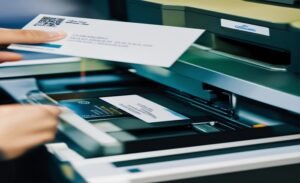Overview
Networking is changing quickly in the digital age, and NFC business cards are leading this change. These creative cards provide a smooth method of connecting with people and exchanging contact details. Let’s explore the world of NFC business cards and see how they’re altering the face of competition.

What are NFC Business Cards?
Two devices may communicate with one another when they are near one another thanks to a technology known as NFC, or near-field communication. With a single tap, NFC business cards can instantly send information to a tablet or smartphone. NFC business cards, in contrast to conventional ones, offer a dynamic means of exchanging professional details in addition to being environmentally beneficial.
The Benefits of Going Digital
Easy Sharing
You don’t need actual business cards when sharing your contact details instantaneously with an NFC business card. It also means that you won’t run out of cards at important networking gatherings.
Update Information Instantly
The real-time information update feature of NFC cards is one of its main benefits. You don’t need new cards to update your digital profile if your contact information or work title changes.
Environmentally Friendly
Because NFC cards can be reused, fewer paper business cards are wasted. They are therefore a great option for professionals that care about the environment.
How to Use NFC Business Cards
Using an NFC business card is straightforward:
- Ensure the recipient’s smartphone is NFC-enabled and unlocked.
- Tap the NFC card against the back of the device.
- A notification will pop up, leading to your digital business profile.
Customizing Your NFC Business Card
Customization is abundant with NFC business cards. You can include links to your portfolio, LinkedIn page, or any other professional website. Even analytics are available from certain suppliers to monitor how frequently your card is used.
1. Select the Correct NFC Chip: Make sure the NFC chip you choose has adequate memory for your requirements. It is customary to use NTAG 215 or 216 for business cards.
2. Create Your Card: Choose the card’s dimensions, style, and color. If you want to stand out, you can choose a size that is more distinctive than a typical credit card.
3. Programming the Chip: Encode your contact information onto the chip using an NFC read/write program such as NFC Tools. A URL pointing to your website, social media accounts, or digital business card might be included.
4. Easily Update Your Information: One benefit of NFC business cards is that you can make digital updates to your contact details without having to reprint your cards.
5. Test Your Card: Make sure your cards are user-friendly and compatible with a range of smartphones by testing them before distributing them.
6. Creative Content: Think about putting a personal touch on it, such as a unique image or a statement that embodies your character or brand.
7. Protect Your Card: Because NFC business cards are electrical, you should think about purchasing protective sleeves to shield them from harm or accidental scans.
Conclusion
The world of networking has changed dramatically with NFC business cards. They provide an eco-friendly, effective, and contemporary means of social interaction. As technology develops further, NFC cards should emerge as the new norm for business-to-business transactions.
FAQ
Are all cell phones compatible with NFC business cards? The majority of contemporary smartphones are NFC-capable, however, it’s advisable to confirm that the recipient’s handset has NFC capability.
Is it possible for me to alter the data on my NFC business card? Definitely! You can change your information at any moment and link to different online profiles.
Are business cards with NFC secure? They are just as safe as any other digital transaction, yes. The data is exchanged solely upon tapping the card on a gadget.
